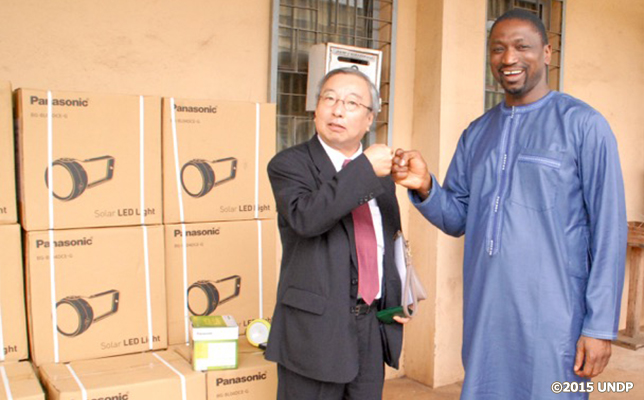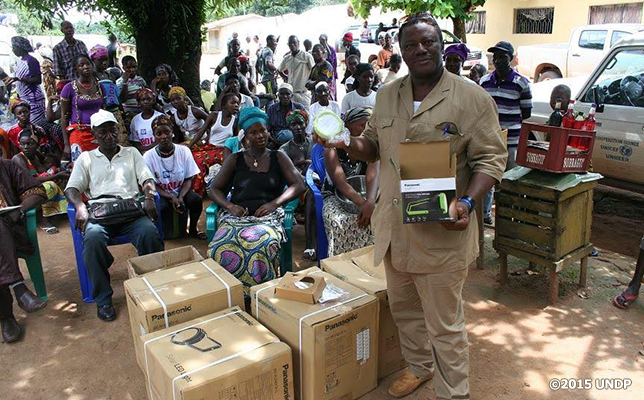2018.07.12News
[Seminar Report] Mainichi Media Café CSR Seminar Bringing Light to People
2015.08.31 News
July 2015, Panasonic donated 3,000 solar lanterns to the United Nations Development Programme (UNDP) as relief support for areas stricken by the Ebola hemorrhagic fever in Guinea, Liberia, and Sierra Leone. This follows a donation of 240 lanterns made in December 2014.
Hello, this is Noriko Tanaka of the CSR & Citizenship Department.
In March 2014, the Ebola hemorrhagic fever broke out in Guinea and spread mainly across West Africa, infecting more than 27,000 people by July 1, 2015. Though the number of those infected has declined significantly since its peak, there are still reports of new infections.
In affected regions, there has been ongoing support day and night to treat patients and quickly take efficient prevention measures. Many of the medical clinics are in areas without electricity, but medical personnel still need reliable light sources to carry on with their work during the night. Also, affected patients' belongings are incinerated to prevent the further spread of the epidemic. This means that once patients recover, when setting off to start again, they do not even have light they need to carry on with their lives. After hearing of such conditions, Panasonic donated a total of 3,240 solar lanterns on two occasions to the UNDP in order to support relief efforts in regions stricken by the disease.
The solar lanterns are also being distributed for daily use by survivors who have lost their jobs due to the illness, and families who have lost their primary provider.
One thousand solar lanterns were distributed in Guinea, where they are used in some areas of Forécariah Prefecture in southwest Guinea that have been isolated to prevent the further spread of Ebola. There, the solar lanterns are used by families who have hardly any resources for carrying on with their lives.

Arrival of solar lanterns observed by H.E. Mr.Naotsugu Nakano, Japanese Ambassador in Republic of Guinea

The presentation ceremony
In Sierra Leone, solar lanterns were distributed in 47 communities. Alice Marrah, a mother of eleven children living in an area without electricity says that she always struggled to purchase the expensive batteries to power the light used for the children's studies. But now, with the solar lanterns, the children are thrilled that they can study all they want every night.
Solar lanterns guide students despite Ebola in Sierra LeoneSolar lanterns guide students' efforts to learn despite the rising cost of energy during Ebola crisis in Sierra Leone.United Nations Development Programme - UNDP in Sierra Leone
Posted by United Nations Development Programme - UNDP
Wisdom Kargbo (24), who lives in the coastal town of Grafton, says that it was difficult to find batteries for the old type of lights. With the Panasonic solar lanterns, two or three people can sit around the light, which makes it easier to study.
In Liberia, a new infection was confirmed two months after containment victory was declared, which led to the isolation of many families in order to prevent any further spread of the disease. In response to these conditions, solar lanterns were delivered to households subject to isolation in Montserrado County, in which the nation's capital is also located. Solar lanterns are also scheduled for delivery to support Bong County on the border with Guinea where damage has been extensive.
Solar lanterns are playing a role in helping the lives of medical professionals who work in the field and people who have been forced to deal with difficulties in daily life as a consequence of Ebola. We hope for the earliest possible containment of the disease.